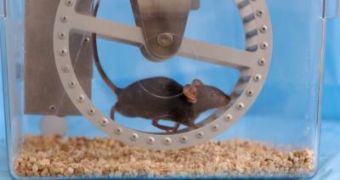Sounds too good to be true? Not quite. Researchers from the Salk Institute for Biological Studies have recently identified two signaling pathways that can be activated through drugs in order to increase endurance. Both pathways are naturally activated through exercise, but the effects of a workout session can be mimicked with the help of drugs, this way helping people unable to move maintain the overall health of the muscle mass.
The latest findings, detailed by Howard Hughes Medical Investigator Ronald M. Evans, Ph.D., and professor at the Salk Institute's Gene Expression Laboratory, follow a similar study carried out by Evans, showing that mice can increase their endurance by permanently activating the gene known as the PPAR delta. Also, this genetic modification allows them to develop resistance to obesity besides experiencing low levels of blood sugar, meaning that the insulin response is also improved.
"We wanted to know whether a drug specific for PPAR delta would have the same beneficial effects. Genetic engineering in humans, commonly known as gene doping when mentioned in connection with athletic performance, is certainly feasible but very impractical," Evans said.
The drug used in the experiment is known as GW1516. "We got the expected benefits in lowering fatty acids and blood glucose levels but no effect, absolutely none, on exercise performance," said Vihang A. Narkar, Ph.D., lead author of the study, while explaining that after one month of feeding the drug to the mice no visible increase in endurance was observed. In order to see whether or not it had any effects at all on the exercise performance of the rodents, the team then started feeding them the drug on a regular basis and have them exercise up to 50 minutes every day.
The results showed that the mice had actually improved their endurance by 77 percent, while the 'slow twitch' muscle fibers increased to 38 percent. Then the obvious question came: why don't sedentary animals show any improvement?
Narkar explains that the power driving the muscles is a chemical known as ATP, which after it delivers its energy turns into AMP. In turn, the increasing concentration of AMP is held in check by a metabolic master regulator known as AMPK, telling the cells when to increase the production of ATP. "That led us to consider whether AMPK activation was the critical trigger that allowed PPAR delta to work," he added.
Although the AMPK is usually found in the cytoplasm, the study showed that some AMPK molecules produced while exercising are able to enter the nucleus of the cell, where they interact with PPAR delta and increase endurance.
"It essentially puts a turbo charge on PPAR delta, which explains why exercise is so important," says Evans. However, even without physical activity the endurance of the mice was still increased by 44 percent by simply feeding them synthetic AMP. "That's as much improvement as we get with regular exercise," Narkar said.

 14 DAY TRIAL //
14 DAY TRIAL //